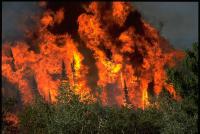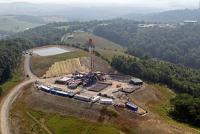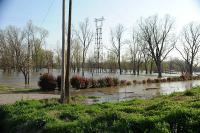-
Small landscape changes can yield big freshwater gains
A typical bird’s-eye view of the Midwest offers a patchwork landscape covered mostly by agriculture but mottled with forest, wetland, grassland, buildings, and pavement. This pattern influences the quality and supply of the many natural benefits the landscape provides people, including freshwater. A new opportunity for improving the health and supply of Wisconsin’s lakes, waterways, and groundwater has emerged from a recent study showing that making small tweaks to how large some of those patches in the pattern are could mean big freshwater benefits, especially where making drastic changes to the landscape would be hard, as is the case throughout much of the state.
-
-
New material enables more efficient desalination

Engineers have found an energy-efficient material for removing salt from seawater. The material, a nanometer-thick sheet of molybdenum disulfide (MoS2) riddled with tiny holes called nanopores, is specially designed to let high volumes of water through but keep salt and other contaminates out, a process called desalination.
-
-
Declining snow packs put many nations' water supplies at risk

Gradual melting of winter snow helps feed water to farms, cities, and ecosystems across much of the world, but this resource may soon be critically imperiled. Scientists have identified snow-dependent drainage basins across the northern hemisphere currently serving two billion people that run the risk of declining supplies as a result of global warming. “Water managers in a lot of places may need to prepare for a world where the snow reservoir no longer exists,” one scientist says.
-
-
Wildfires may double erosion across a quarter of western U.S. watersheds by 2050

Wildfires, which are on the rise throughout the west as a result of prolonged drought and climate change, can alter soil properties and make it more vulnerable to erosion. A new study shows that the increase in wildfires may double soil erosion in some western United States by 2050, and all that dirt ends up in streams, clogging creeks and degrading water quality.
-
-
Bad governance is a threat to freshwater supply
Scientists have analyzed nineteen different characteristics critical to water supply management in 119 low per capita income countries and found that vulnerability is pervasive and commonly arises from relatively weak institutional controls. The study sought to identify freshwater supply vulnerabilities using four broad categories: endowment (availability of source water), demand, infrastructure, and institutions (for example, government regulations).
-
-
Managing urban stormwater runoff better
As meteorologists monitor the El Nino condition currently gaining strength in the Pacific Ocean, Californians look with hope to the much-needed rain and snow it could yield. But if Californians are going to make the most of the precipitation, they need to put a LID on it. LIDs, or low-impact development technologies, mimic pre-urban stream functions. Examples are green roofs that absorb and evapotranspire rainfall; rainwater tanks attached to homes and other buildings; and permeable pavement for roads, driveways and parking lots. Rainwater could even be used in the home for toilet flushing and laundry.
-
-
Instant water heater offers energy, cost savings
Traditional water heaters take time to reach preferred temperatures, thus wasting water and energy. A new instant hot water solution, developed through the EU-funded RAPIDHEAT project, successfully optimized heating and control technologies to develop a lightweight low thermal mass heater that provides full temperature output within two seconds of switch-on.
-
-
Understanding monsoons for better predictions of Indian weather
Summer, or southwest, monsoons are moisture-soaked seasonal winds that bring critical rainfall to the Indian subcontinent during the June-September wet season. An abundant season provides sustaining rainfall that replenishes water reservoirs and reaps bountiful crop harvests. By contrast, a weak season could lead to drought, soaring food prices and a battered economy. Better to understand global weather patterns and increase scientific collaboration between the United States and India, researchers have completed a month-long cruise studying summer monsoon conditions in the Bay of Bengal.
-
-
Storms after wildfire degrade water quality
About half of the water supply in the southwestern United States is supplied by water conveyed from forests, which generally yield higher quality water than any other land use. However, forests are vulnerable to wildfire; more than twelve million acres of land, including important forested water-supply watersheds, have burned in the southwestern United States in the past thirty years. Wildfires increase susceptibility of watersheds to both flooding and erosion, and thus can impair water supplies.
-
-
U.S. fracking uses less than 1 percent of total industrial water use nationwide

Energy companies used nearly 250 billion gallons of water to extract unconventional shale gas and oil from hydraulically fractured wells in the United States between 2005 and 2014, a new study finds. During the same period, the fracked wells generated about 210 billion gallons of wastewater. Large though those numbers seem, the study calculates that the water used in fracking makes up less than 1 percent of total industrial water use nationwide.
-
-
Wastewater to irrigate, fertilize, and generate energy
To meet the requirements of Asian cities, researchers are adapting an idea they have already applied in Germany for comprehensive water management: They are developing a concept for reducing water use, treating wastewater and extracting fertilizer for a strip of coastline in the Vietnamese city of Da Nang.
-
-
Helping replenish groundwater by flooding farms in the winter

California is in chronic groundwater overdraft: There is more water being pumped from the ground than filtering in, and the state’s aquifers are shrinking as more growers pump groundwater to keep crops alive. But that fertile farmland may also provide the means for replenishing groundwater to benefit everyone in the drought-stricken state. Researchers at the University of California, Davis, are encouraged by early results from tests to see whether deliberately flooding farmland in winter can replenish aquifers without harming crops or affecting drinking water.
-
-
Snowpack of Sierra Nevada lowest in 500 years, worsening California water woes

Snowpack in California’s Sierra Nevada in 2015 was at the lowest level in the past 500 years, according to a new report. “Our study really points to the extreme character of the 2014-15 winter. This is not just unprecedented over 80 years — it’s unprecedented over 500 years,” said the lead author of the report. On 1 April of this year, California Governor Jerry Brown declared the first-ever mandatory water restrictions throughout the state while standing on dry ground at 6,800-foot elevation in the Sierra Nevada. The historical average snowpack on that site is more than five feet, according to the California Department of Water Resources.
-
-
Innovative method filters seawater in minutes
Researchers have unveiled a cost-effective desalination technology which can filter highly salty water in minutes. The technology is based on membranes containing cellulose acetate powder, produced in Egypt. The powder, in combination with other components, binds the salt particles as they pass through, making the technique useful for desalinating seawater.
-
-
2015 drought costs for California agriculture: Loss of $1.84 billion, 10,100 jobs

The drought is tightening its grip on California agriculture, squeezing about 30 percent more workers and cropland out of production than in 2014, according to the latest drought impact report. In 2015, the state’s agricultural economy will lose about $1.84 billion and 10,100 seasonal jobs because of the drought, the report estimated, with the Central Valley hardest hit. The heavy reliance on groundwater comes at ever-increasing energy costs as farmers pump deeper and drill more wells. Some of the heavy pumping is in basins already in severe overdraft — where groundwater use greatly exceeds replenishment of aquifers — inviting further land subsidence, water quality problems, and diminishing reserves needed for future droughts.
-
More headlines
The long view
Water Wars: A Historic Agreement Between Mexico and US Is Ramping Up Border Tension
As climate change drives rising temperatures and changes in rainfall, Mexico and the US are in the middle of a conflict over water, putting an additional strain on their relationship. Partly due to constant droughts, Mexico has struggled to maintain its water deliveries for much of the last 25 years, deliveries to which it is obligated by a 1944 water-sharing agreement between the two countries.
